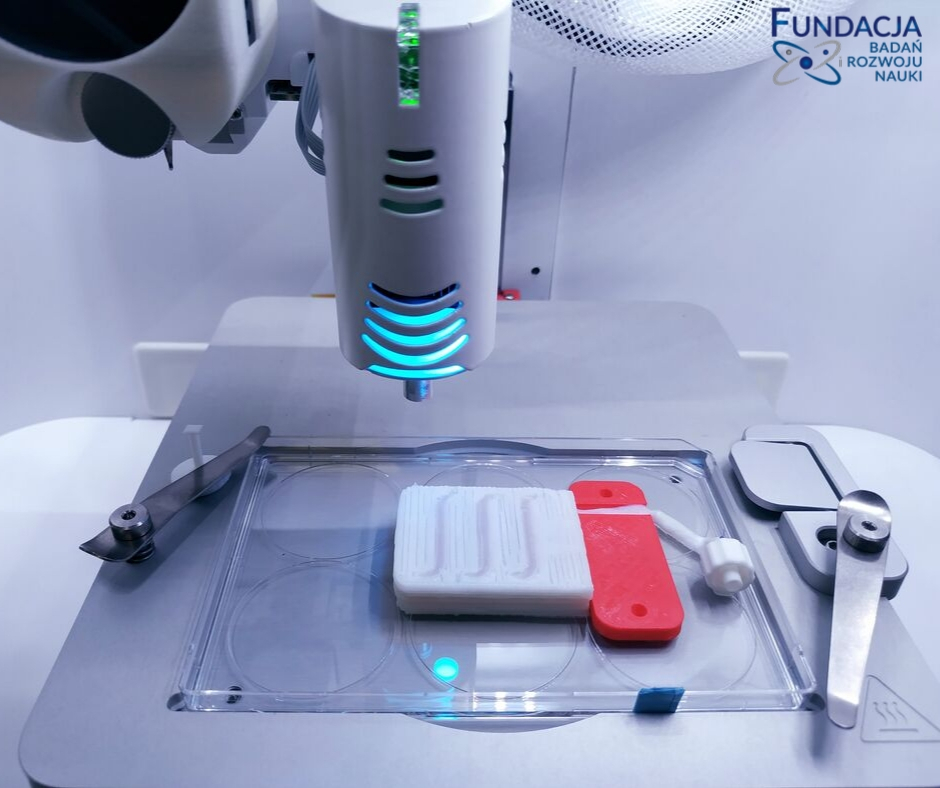
Professor Grazyna Ginalska remembers this patient very well. His name was Daniel Bardega. “He was a young man, a twenty-something year old. He was sitting on the back seat of a motorcycle when the accident happened. The crash threw him into the air. His thigh bone was so smashed that seven centimeters of his bone were missing. The doctors wanted to amputate his leg,” she says.
The man found out about a medical experiment being carried out in Lublin (Poland). Instead of cutting his leg off, the doctors implanted a few pieces of something that resembled a piece of pumice stone into the man’s leg and saved his leg this way. Today, 6 years after the operation, both legs of the unlucky motorcyclist are in working order. He walks unaided without crutches, and the only remnant of the accident is a slight limp.
These few bits of “pumice” implanted in the patient are referred to as FlexiOss. This is an artificial bone invented by Prof. Grażyna Ginalski and Prof. Anna Belcarz at the Medical University of Lublin (eastern Poland). “FlexiOss is a synthetic material that is very similar to human bone. It is made up of hydroxyapatite for 90 percent. The same material that is present in our bones in large quantities. Just like bone made of polymers, but we used sugar polymer instead of collagen (which is in real bones). As is the case with real bone, it has micro- and macrophores, which blood vessels and new bone cells penetrate the bone through,” Prof. Grażyna Ginalska explains.
Prof. Ginalska started working on artificial bone 15 years ago. She was encouraged to do so by orthopedic doctors, who often complained about the bone substitute materials then in use. The materials were in the form of powder or granules and used to spill out. It was impossible to shape them. The doctors needed something that would be stiff and still be easy to adjust their shape. These are the qualities of FlexiOss. Straight out of the box, the ‘bone’ is hard and looks like pumice stone. Once it is wettened by the patient’s blood and saline, it becomes flexible and can be shaped like modeling clay during surgery. After the implantation of FlexiOss, the patient’s osteoblasts (bone-forming cells) treat the artificial bone like a scaffold and within a few months, the process of bone reconstruction starts to take place.
So far, FlexiOss has been used in medical experiments and clinical trials. In total, the preparation has been implanted in more than 40 patients. Some, like Daniel Bardega, were missing bone fragments after an accident. In the second group, there were people who had already had other bone replacement materials implanted, but their bodies did not accept these preparations well enough. As Professor Ginalska emphasizes, FlexiOss seems to work well in both groups. Although the research is not finished yet, FlexiOss has been CE-marked for several months already. This means it can be sold in the European Union.
While the operation of an unlucky motorcyclist was taking place in Lublin, in another Polish city, Warsaw, dr. Michał Wszoła and his team started making preparations for the creation of a bionic pancreas. In short, dr. Wszoła decided to try to print a living pancreas on a 3D printer.

According to the WHO, 422 million people in the world have diabetes – a chronic disease whereby glucose levels in the body increase to unhealthy levels. Untreated, diabetes can quickly lead to dangerous complications and even death. Most patients have to inject insulin, a hormone that lowers their blood sugar levels, for the rest of their lives. However, there is a group of patients for whom insulin injections do not work. Their chances of recovery lie with a pancreas transplant. Provided that there is an organ available for the transplant operation that is. Yet there are simply not enough of these. Dr. Wszoła started his research with these types of patients in mind.
“We want to offer patients something that is as effective as a pancreatic transplant, as non-invasive as pancreatic islet transplantation, and at the same time, there’s no need to wait for a donor. Hence the idea to print a living organ on a 3D printer built out of living cells that respond to stimuli from the body. Because we print it ourselves and start out by printing it with cells taken from the patient, we can then get it to perfectly fit the vascular system,” Michał Wszoła goes on to explain.
In order to print a living organ, the scientists had to develop several innovative technologies. They started out by creating two types of bio-ink for printing. The first type, used to print the pancreas itself, consists of living pancreatic islet cells, which produce insulin and substances that imitate the extracellular matrix, i.e. a substance that maintains and nourishes pancreatic cells. The second type is used to print the vascular system. It contains, among other things, endothelial cells, which build blood vessels in the human body.
Then the scientists developed a ‘bioreactor’ that works as a kind of incubator. It is a special vessel that is filled with perfusion fluid which has oxygen and nutrients that enable the printed pancreas to survive outside the body.
In March 2019, after entering nearly 40 thousand commands into the 3D printer, Polish scientists became the first in the world to print a pancreas. A living one, with a complete vascular system and one that produced insulin in response to sugar growth. The bionic pancreas does not look like the real thing. It’s a small 3 x 3 x 5 cm snippet. “We didn’t even want the bionic pancreas to look like a real one because transplanting it would then lead to a lot of vascular complications. Our pancreas is meant to have a very good vascular system and good blood circulation, it doesn’t need to look natural,” Michał Wszoła notes.
The world’s first bionic pancreas has been turned into a microscopic concavity slide. So, now the team started working on improving the prototype and testing it on animals. The experiments with mice are slowly coming to an end. Rodents were implanted with a small piece of the bionic pancreas to check how the organ behaves in a living organism, i.e. how blood vessels grow, whether it causes any inflammatory reactions, etc. A few weeks ago, scientists reached the next phase of the project and started testing it on pigs. These animals are already having a normal-sized bionic pancreas implanted in order to find out where the best place in the body would be to transplant such an organ.
If everything goes well, the scientists anticipate that in about 2 years’ time the first trials of bionic pancreases in humans will be possible. For the time being, a company has been set up that is seeking funding for further work and opportunities to commercialize their invention.


